


We live in progressive times, when even chess publishers are acknowledging the huge contributions given by women to our beloved sport! Only a few books on different women champions have been published.
I have a keen interest in knowing champions of the past, especially when they were women, because I cannot imagine how difficult must have been for them to enter in a male dominated field, and not give up, but continue to fight until they reached the top!
The best publisher for historical and biographical chess books is clearly McFarland. The quality of their products is unmatched. When this book came out, I got a copy right away. I admit my ignorance about Vera Menchik, and wanted to know more about her, and her historical chess period. For me a book is worth it if it teaches me something I don't know. Otherwise it is a waste of time, and money. I confess I was — especially growing up — an avid reader, since my average was around 80 to 100 books a year. Now, I'm older, family, work, the internet and social apps have clearly swallowed good chunk of the time!
The book begins with an introduction which reveals important information on how society and chess were treating women in the past. On page 3 we find: "As recently as 1937, none of the chess clubs in Boston allowed female members." This changed in 1938. Digressing, let's note another amazing contribution made by the author: the collection of the games of Vera Menchik. Now, why is this important? Well with a click on my Megabase 2018, I can have more than 2500 games played by Alekhine, but it seems that in the past, the biographies treating Vera Menchik had something like less than 100 of her games.
In this book, thanks to the relentless dedication of the author in collecting books in different languages, and translating them, we have 350 games played by Vera Menchik. Just for this incredible collection of games, the book is a must have!

Thanks to these games we can assess the quality of chess playing in the 1920-30s.
But back to the historical period: While in USA, chess clubs in Boston didn't allow female members up to 1937-38, limiting opportunities for women relative to their male peers, in Hastings, England, already in 1923 female members were accepted — so 14-15 years sooner.
This book doesn't have many pictures of Vera Menchik, because as the author explains in the introduction (page 4) often the quality was too poor for printing, or it was impossible to track down the ownership of the picture for credits.
I totally ascribe to the author idea that chess is a culture, which cannot be based only on pushing plastic pieces on a board, or the result of the last tournament. And we should all do our part in knowing the champions of the past, which have molded our modern chess world.
(Above) Vera Menchik circa 1937 | [Public domain], via Wikimedia Commons
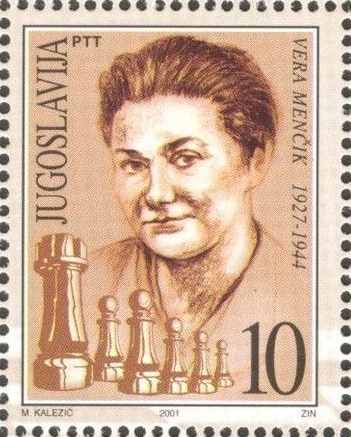 An interesting choice by the author was not to comment the games played by Vera Menchik in the way today modern masters would annotate them. Instead he preferred to use the annotations and comments published in Vera Menchik's historical period.
An interesting choice by the author was not to comment the games played by Vera Menchik in the way today modern masters would annotate them. Instead he preferred to use the annotations and comments published in Vera Menchik's historical period.
(Right) Menchik on a commemerative postage stamp of Yugoslavia | [Public domain], via Wikimedia Commons
The loose biography provided by the author, clearly shows how just a little more than 100 years ago, was difficult to know something about someone, who clearly wasn't famous and important. For example, it is quite strange that Vera Menchik's mother, whose last name was Illingworth — a typical English name — was living in Russia. Vera was born in 1906, and her family was able to escape from the Soviet Union in 1921.
Through the biography we come to know that Vera choose chess as hobby, because it was quiet, and didn't oblige her to speak in English. Clearly it must have been difficult for her to learn, but again, it is unclear on the reasons the mother never taught her English. By 1933, it seems, she was able to speak English well, as noted on the biography by Salo Flohr on Menchik.
In the book there was an interesting comment about her chess strength when she joined the Hastings chess Club; on page 10 we find: "a weak second class player, possibly a C-player by present US standards." For the United States Chess Federation (USCF), a C-player is rated from 1400 to 1599.
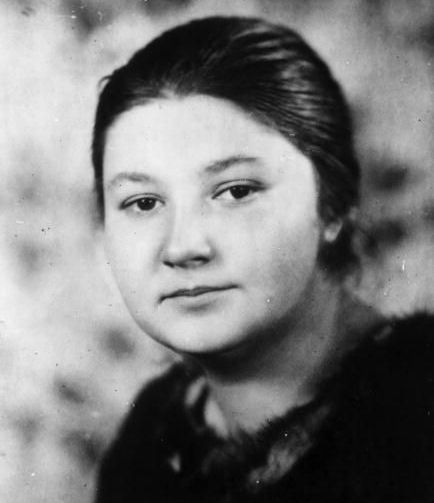
Vera Menchik at age 16 | Photo: Menchik biography, page 11, original source: Chess Review, June 1969
It is clear that Miss Menchik progressed fast, because in England during that time there were many team matches organized between clubs, and she rose from board 26 in 1923, to board 1 and 2 by 1930. Her biographer mentions the tournaments she won. She was coached by the legendary grandmaster Géza Maróczy.
(Below) Maróczy in 1906 | [Public domain], via Wikimedia Commons
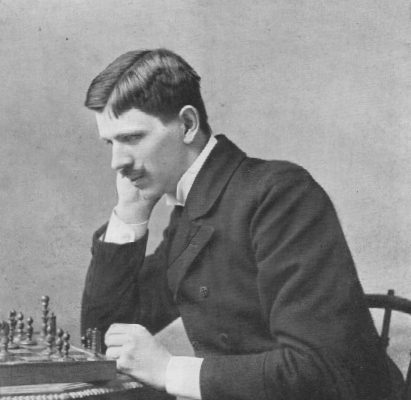
Today we remember that name for a pawn formation, but Maróczy also authored many chess books. He was also evidently a great coach, since Menchik was already playing the 1st Class section of the 1923-24 Hastings Christmas Congress.
Enough with the biography (Part I), because I don't want to spoil all the surprises, and the good reading one should do. Let's look at the rest of the book.
Part II is her games, events and crosstables. This book is a great example for other chess publishers, because the quality, and clarity of the material makes it stand out. For example I loved to browse through the crosstables, and be able at a glance to see how Miss Menchik performed, and against which field. Here an example from one page of the book:
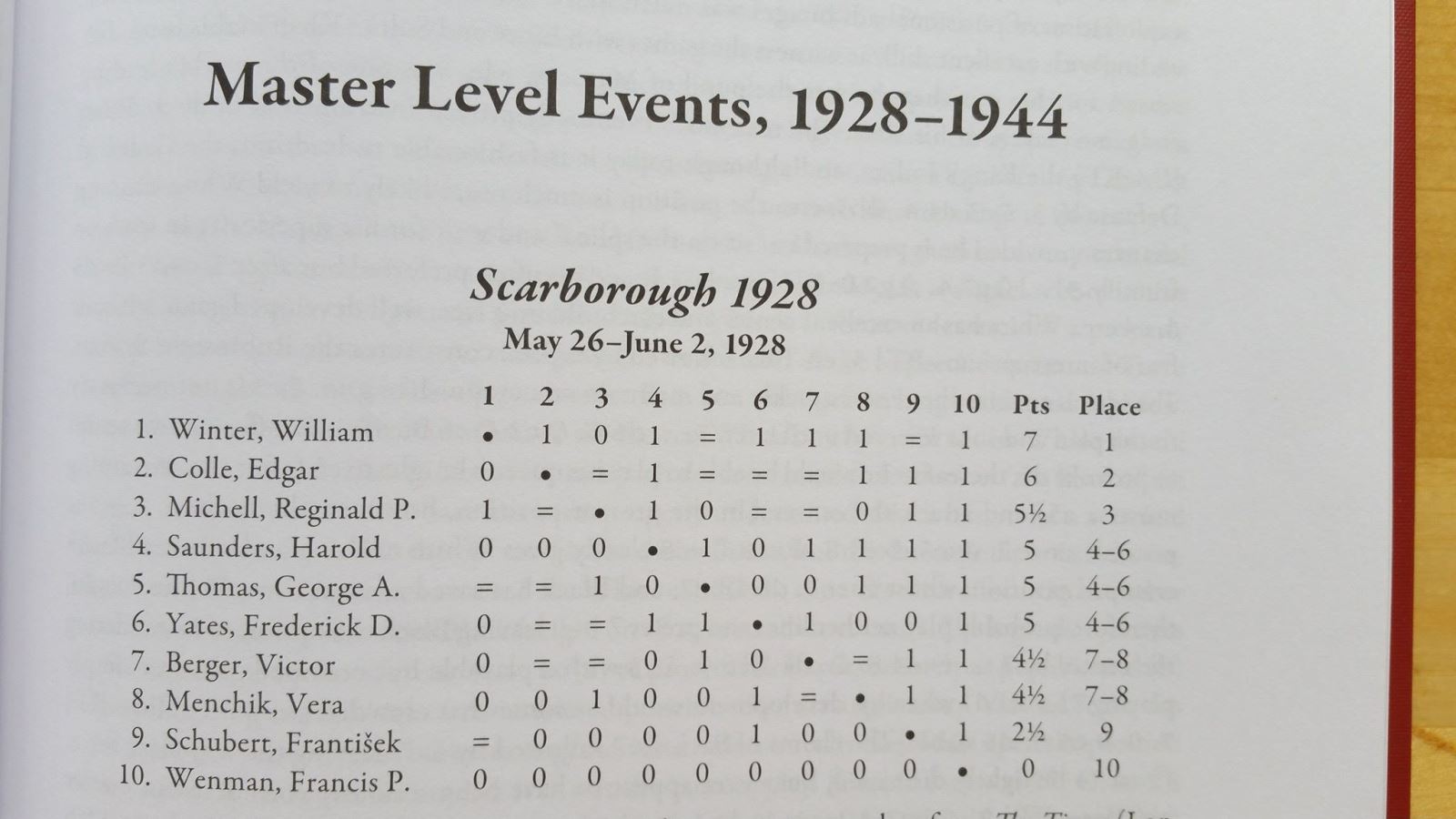
Then of course one can see how well the games are annotated.
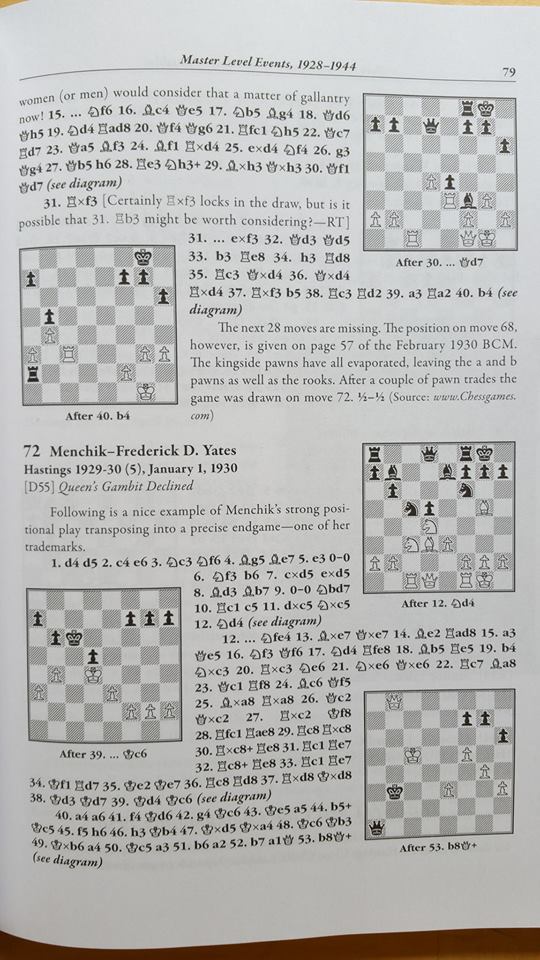
I also found interesting to know that she played against some of the legendary classical players in matches, like the following with Jacques Mieses.

Part III of the book is dedicated to the writings by Vera Menchik, her articles on openings, middlegame, endgame, and even a political dialog!
The book ends with Part IV, based on appendices, Notes, bibliography, and indices.
Clearly this is how a historical chess book should be: highly informative, but also bringing to life a champion who lived a long time ago. I enjoyed it, and am quite happy that it will add quality to my chess library.
Here are just a few games played by Vera Menchik against other legendary players. This will surely challenge the bias that women play worse chess than men.
This bias, which unfortunately still exists today, is reflected in the following short story from The Encyclopaedia of Chess by A. Sunnucks (London, 1976) as quoted by Edward Winter (C.N. 3433):
The invitation to Vera Menchik to compete among such players as Capablanca, Euwe, Tartakower and Nimzowitsch was received with amusement by many of the masters. The Viennese master Becker was particularly scornful, and in the presence of a number of the competitors he suggested that anyone who lost to Vera Menchik should be granted membership of the Menchik Club. He himself became the first member.
Many top male players of that period became members of such exclusive "club" too many to mention, here few of the games with some of its most famous members.
The name Edgar Colle should ring a bell, since surely many play the Colle System, or bought opening books on the Colle.
For those who don't know Khan, he was British Champion in 1929, 1932 and 1933, a chess genius from India, and considered to be one of the strongest players of that period. Today India is producing many more chess geniuses, and we must all keep an eye on these great players!
Of course also the fifth world champion Max Euwe doesn't need any presentation!
And for those who are still not convinced, how great this chess player was, let me show you the following position:
White just played 25.Rxf7; which is a big blunder, can you see how Black continues?
The tactical idea behind is a very simple mating pattern, but at the end will leave Black a piece up!
A great book, high quality paper, improving everyone chess library with the life and games of a great woman, who unfortunately died young under the bombshells of World War II. Don't miss the chance to know more about chess history, and great players from the past like Vera Menchik!
Vera Menchik — A Biography of the First Women’s World Chess Champion, with 350 Games
316 pages
Published by McFarland